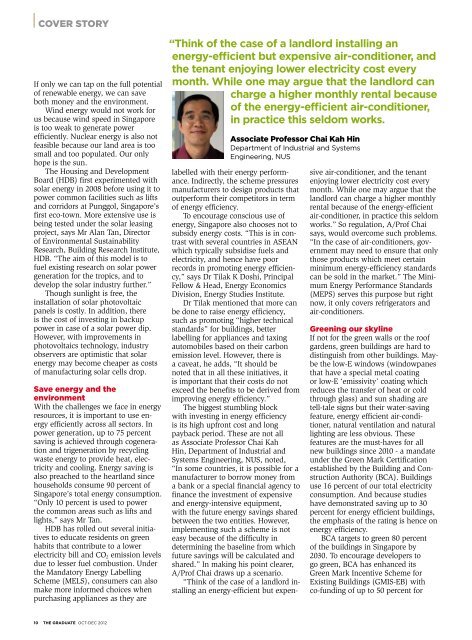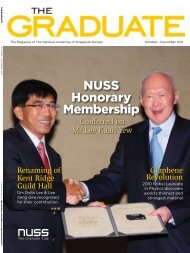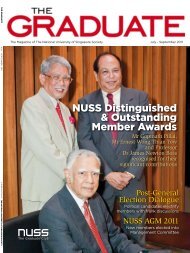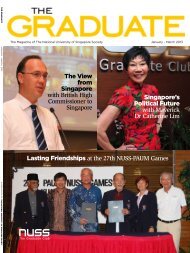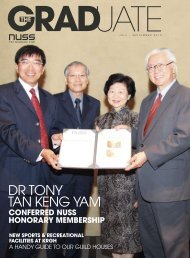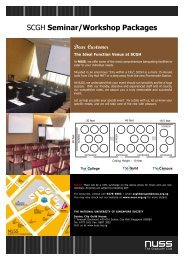NUSS bids farewell to Suntec City Guild House for the
NUSS bids farewell to Suntec City Guild House for the
NUSS bids farewell to Suntec City Guild House for the
Create successful ePaper yourself
Turn your PDF publications into a flip-book with our unique Google optimized e-Paper software.
Cover s<strong>to</strong>ry<br />
If only we can tap on <strong>the</strong> full potential<br />
of renewable energy, we can save<br />
both money and <strong>the</strong> environment.<br />
Wind energy would not work <strong>for</strong><br />
us because wind speed in Singapore<br />
is <strong>to</strong>o weak <strong>to</strong> generate power<br />
efficiently. Nuclear energy is also not<br />
feasible because our land area is <strong>to</strong>o<br />
small and <strong>to</strong>o populated. Our only<br />
hope is <strong>the</strong> sun.<br />
The Housing and Development<br />
Board (HDB) first experimented with<br />
solar energy in 2008 be<strong>for</strong>e using it <strong>to</strong><br />
power common facilities such as lifts<br />
and corridors at Punggol, Singapore’s<br />
first eco-<strong>to</strong>wn. More extensive use is<br />
being tested under <strong>the</strong> solar leasing<br />
project, says Mr Alan Tan, Direc<strong>to</strong>r<br />
of Environmental Sustainability<br />
Research, Building Research Institute,<br />
HDB. “The aim of this model is <strong>to</strong><br />
fuel existing research on solar power<br />
generation <strong>for</strong> <strong>the</strong> tropics, and <strong>to</strong><br />
develop <strong>the</strong> solar industry fur<strong>the</strong>r.”<br />
Though sunlight is free, <strong>the</strong><br />
installation of solar pho<strong>to</strong>voltaic<br />
panels is costly. In addition, <strong>the</strong>re<br />
is <strong>the</strong> cost of investing in backup<br />
power in case of a solar power dip.<br />
However, with improvements in<br />
pho<strong>to</strong>voltaics technology, industry<br />
observers are optimistic that solar<br />
energy may become cheaper as costs<br />
of manufacturing solar cells drop.<br />
save energy and <strong>the</strong><br />
environment<br />
With <strong>the</strong> challenges we face in energy<br />
resources, it is important <strong>to</strong> use energy<br />
efficiently across all sec<strong>to</strong>rs. In<br />
power generation, up <strong>to</strong> 75 percent<br />
saving is achieved through cogeneration<br />
and trigeneration by recycling<br />
waste energy <strong>to</strong> provide heat, electricity<br />
and cooling. Energy saving is<br />
also preached <strong>to</strong> <strong>the</strong> heartland since<br />
households consume 90 percent of<br />
Singapore’s <strong>to</strong>tal energy consumption.<br />
“Only 10 percent is used <strong>to</strong> power<br />
<strong>the</strong> common areas such as lifts and<br />
lights,” says Mr Tan.<br />
HDB has rolled out several initiatives<br />
<strong>to</strong> educate residents on green<br />
habits that contribute <strong>to</strong> a lower<br />
electricity bill and CO2 emission levels<br />
due <strong>to</strong> lesser fuel combustion. Under<br />
<strong>the</strong> Manda<strong>to</strong>ry Energy Labelling<br />
Scheme (MELS), consumers can also<br />
make more in<strong>for</strong>med choices when<br />
purchasing appliances as <strong>the</strong>y are<br />
10 THE GRADUATE Oct-Dec 2012<br />
“Think of <strong>the</strong> case of a landlord installing an<br />
energy-efficient but expensive air-conditioner, and<br />
<strong>the</strong> tenant enjoying lower electricity cost every<br />
month. While one may argue that <strong>the</strong> landlord can<br />
charge a higher monthly rental because<br />
of <strong>the</strong> energy-efficient air-conditioner,<br />
in practice this seldom works.<br />
Associate Professor Chai Kah Hin<br />
Department of Industrial and Systems<br />
engineering, NUS<br />
labelled with <strong>the</strong>ir energy per<strong>for</strong>mance.<br />
Indirectly, <strong>the</strong> scheme pressures<br />
manufacturers <strong>to</strong> design products that<br />
outper<strong>for</strong>m <strong>the</strong>ir competi<strong>to</strong>rs in term<br />
of energy efficiency.<br />
To encourage conscious use of<br />
energy, Singapore also chooses not <strong>to</strong><br />
subsidy energy costs. “This is in contrast<br />
with several countries in ASEAN<br />
which typically subsidise fuels and<br />
electricity, and hence have poor<br />
records in promoting energy efficiency,”<br />
says Dr Tilak K Doshi, Principal<br />
Fellow & Head, Energy Economics<br />
Division, Energy Studies Institute.<br />
Dr Tilak mentioned that more can<br />
be done <strong>to</strong> raise energy efficiency,<br />
such as promoting “higher technical<br />
standards” <strong>for</strong> buildings, better<br />
labelling <strong>for</strong> appliances and taxing<br />
au<strong>to</strong>mobiles based on <strong>the</strong>ir carbon<br />
emission level. However, <strong>the</strong>re is<br />
a caveat, he adds, “It should be<br />
noted that in all <strong>the</strong>se initiatives, it<br />
is important that <strong>the</strong>ir costs do not<br />
exceed <strong>the</strong> benefits <strong>to</strong> be derived from<br />
improving energy efficiency.”<br />
The biggest stumbling block<br />
with investing in energy efficiency<br />
is its high upfront cost and long<br />
payback period. These are not all<br />
as Associate Professor Chai Kah<br />
Hin, Department of Industrial and<br />
Systems Engineering, NUS, noted,<br />
“In some countries, it is possible <strong>for</strong> a<br />
manufacturer <strong>to</strong> borrow money from<br />
a bank or a special financial agency <strong>to</strong><br />
finance <strong>the</strong> investment of expensive<br />
and energy-intensive equipment,<br />
with <strong>the</strong> future energy savings shared<br />
between <strong>the</strong> two entities. However,<br />
implementing such a scheme is not<br />
easy because of <strong>the</strong> difficulty in<br />
determining <strong>the</strong> baseline from which<br />
future savings will be calculated and<br />
shared.” In making his point clearer,<br />
A/Prof Chai draws up a scenario.<br />
“Think of <strong>the</strong> case of a landlord installing<br />
an energy-efficient but expen-<br />
sive air-conditioner, and <strong>the</strong> tenant<br />
enjoying lower electricity cost every<br />
month. While one may argue that <strong>the</strong><br />
landlord can charge a higher monthly<br />
rental because of <strong>the</strong> energy-efficient<br />
air-conditioner, in practice this seldom<br />
works.” So regulation, A/Prof Chai<br />
says, would overcome such problems.<br />
“In <strong>the</strong> case of air-conditioners, government<br />
may need <strong>to</strong> ensure that only<br />
those products which meet certain<br />
minimum energy-efficiency standards<br />
can be sold in <strong>the</strong> market.” The Minimum<br />
Energy Per<strong>for</strong>mance Standards<br />
(MEPS) serves this purpose but right<br />
now, it only covers refrigera<strong>to</strong>rs and<br />
air-conditioners.<br />
Greening our skyline<br />
If not <strong>for</strong> <strong>the</strong> green walls or <strong>the</strong> roof<br />
gardens, green buildings are hard <strong>to</strong><br />
distinguish from o<strong>the</strong>r buildings. Maybe<br />
<strong>the</strong> low-E windows (windowpanes<br />
that have a special metal coating<br />
or low-E ‘emissivity’ coating which<br />
reduces <strong>the</strong> transfer of heat or cold<br />
through glass) and sun shading are<br />
tell-tale signs but <strong>the</strong>ir water-saving<br />
feature, energy efficient air-conditioner,<br />
natural ventilation and natural<br />
lighting are less obvious. These<br />
features are <strong>the</strong> must-haves <strong>for</strong> all<br />
new buildings since 2010 - a mandate<br />
under <strong>the</strong> Green Mark Certification<br />
established by <strong>the</strong> Building and Construction<br />
Authority (BCA). Buildings<br />
use 16 percent of our <strong>to</strong>tal electricity<br />
consumption. And because studies<br />
have demonstrated saving up <strong>to</strong> 30<br />
percent <strong>for</strong> energy efficient buildings,<br />
<strong>the</strong> emphasis of <strong>the</strong> rating is hence on<br />
energy efficiency.<br />
BCA targets <strong>to</strong> green 80 percent<br />
of <strong>the</strong> buildings in Singapore by<br />
2030. To encourage developers <strong>to</strong><br />
go green, BCA has enhanced its<br />
Green Mark Incentive Scheme <strong>for</strong><br />
Existing Buildings (GMIS-EB) with<br />
co-funding of up <strong>to</strong> 50 percent <strong>for</strong>


